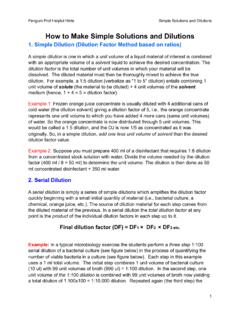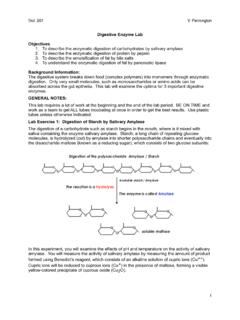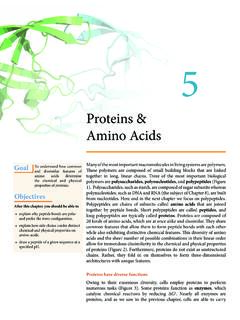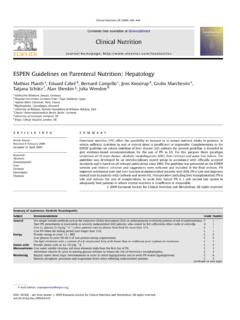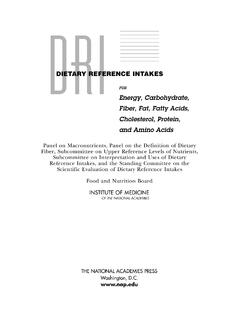Transcription of SEPARATION OF AMINO ACIDS BY PAPER CHROMATOGRAPHY
1 Biol. 261 1 SEPARATION OF AMINO ACIDS BY PAPER CHROMATOGRAPHY CHROMATOGRAPHY is a convenient and useful method for the SEPARATION of mixtures and for the identification of substances. The method has been especially valuable for the SEPARATION of closely related compounds. There are many different types of CHROMATOGRAPHY , but in this experiment we will illustrate the method with the SEPARATION of AMINO ACIDS by PAPER CHROMATOGRAPHY . We will be using four common AMINO ACIDS : arginine, glutamic acid , leucine and valine. Each has a structure, which can be represented by where R represents the parts of the structure which are different with each AMINO acid .
2 The two groups common to all AMINO ACIDS are the -NH2 group (the AMINO group) and the -COOH group (the carboxylic acid group). The basic procedure in this experiment consists of applying a small drop of the solution containing the substances to be separated near one end of a strip of absorbent PAPER . This end of the PAPER is then placed into a developing solvent, which flows upward along the PAPER by capillary action. The degree of solubility of the components of the mixture in the solvent, as well as the degree of attraction of these components to the wet cellulose molecules in the PAPER fibers, will determine the distance that the solvent will carry each substance along the PAPER during a given time interval.
3 Those components that are quite soluble in the developing solvent, or that have a low affinity for cellulose, will be carried the greatest distance from the origin. The finished PAPER , with its spots, is called a chromatogram. In this experiment, distances traveled by spots of various compounds will be compared on a single sheet of PAPER . It is a common procedure to measure the ratio of the distance the spot moves to the total distance the solvent front moves (beyond the original location of the spot) under the conditions of the experiment. This ratio is called the Rf value and is defined as: Tables of Rf values are published for many compounds under various conditions.
4 Distances are measured to the center of the spots. When spots of unknown compounds are placed on the same chromatogram as spots of known materials it is often sufficient, under good experimental conditions, to compare distances from the starting line for knowns and unknowns. In simple cases, this is all that is required in order to identify the unknown. C C HRNH2 OHO distance the spot travels distance the solvent travels Rf = 2 The positions of colored substances on a chromatogram are easily detected by the human eye, while a colorless substance may be made visible by treatment with a reagent that converts it to a colored compound.
5 For example, AMINO ACIDS , which are all colorless by themselves, give a blue or purple color when they react with ninhydrin. Therefore, AMINO ACIDS may be detected on a chromatogram by treatment with ninhydrin reagent. Other methods of detecting colorless materials on a chromatogram include the use of ultraviolet light to detect fluorescent compounds, or the use of a Geiger counter to detect radioactive samples. In this experiment you will carry out PAPER CHROMATOGRAPHY in order to understand the basic principles of this SEPARATION technique. You will calculate the Rf values for known and unknown components of your AMINO acid solutions and use this information to identify the components of your unknown AMINO acid solution.
6 Safety Precautions Wear gloves when using ninhydrin solvent Use different toothpicks for each AMINO acid and unknowns so that cross contamination can be avoided. Dispose of any left over developing solvent (butanol/acetic acid /water) in reclaim container provided. No solvent should be allowed to go down the drain. Butanol is a flammable liquid. Make sure there are no open flames and/or heat near the developing solvent. EXPERIMENTAL PROCEDURE 1. PREPARATION OF THE CHROMATOGRAPHIC PAPER CAUTION: Wearing gloves, handle the PAPER (Whatman no. 1) only along the narrow edges.
7 Use PAPER towels to protect the PAPER from the desk surface and from your hands. Remember that your skin contains AMINO ACIDS and therefore you must avoid any contact with the part of the PAPER to be used in the analysis. Take a rectangle of the PAPER that is cut (typically about 11 cm, x 20 cm) so that the width of the PAPER is just a little less than the depth of an 800 mL beaker and its length is enough to permit the formation of a cylinder that will fit inside of the beaker without touching its walls. 3 Still wearing your gloves, make a light pencil line cm from one long edge. Place six equally spaced pencil marks along this line, keeping the end markings about cm from the ends.
8 Label the first four marks with the abbreviations of the four AMINO acid knowns, and the remaining two spots with the unknown numbers. Arg Glu Leu Val Unk Unk } cm cm Use a toothpick to put a small drop of the solution onto the PAPER at the appropriate mark along the line. When the solvent has evaporated, transfer another drop to the PAPER . Repeat this 4 or 5 times, allowing the spot to dry each time. The goal is to keep the spot under 4 mm in diameter and to make repeat applications to build up the concentration of the material without enlarging the spot appreciably.
9 Be sure that you use toothpicks only for their designate solutions and do not mix applicators among solutions. Allow the spots to dry again. Be sure to record in your notebook any observations you may make about the physical properties of the known and unknown AMINO acid solutions. 2. SETTING UP THE DEVELOPING SOLVENT Use a clean dry 800 mL beaker and the developing solvent (butanol/acetic acid /water) from the supply in the HOOD, taking only what you need (ONLY 30 mL). Record your observations on the properties of the solvent. Note also the location of the reclaim bottle in the HOOD that will be used for any unused or extra solvent at the end of the experiment.
10 NO SOLVENT SHOULD BE ALLOWED TO GO DOWN THE DRAIN. Use a glass rod to add enough solvent to the beaker to cover the bottom to about cm in depth. Do this without splashing the sides of the beaker with the solvent. 3. RUNNING THE CHROMATOGRAPHIC SEPARATION Coil the spotted PAPER into a cylinder and fasten the two short ends together with stapler. Do not overlap the ends of the PAPER . A gap of one or two millimeters space between PAPER edges is helpful. Set the PAPER cylinder, spotted edge down, into the beaker containing the solvent solution. The pencil line with the spots must be above the liquid level. The PAPER should not touch the sides of the beaker.
